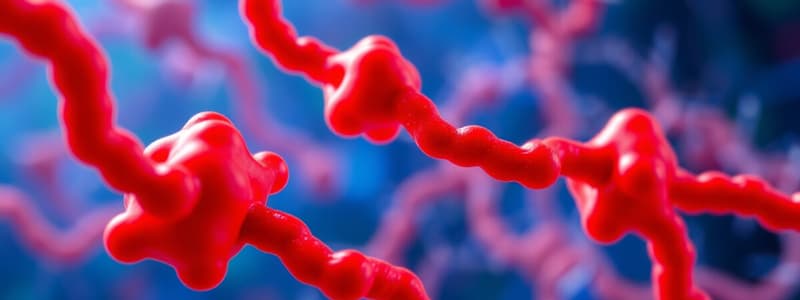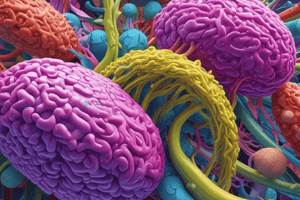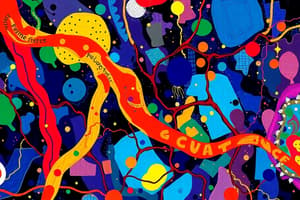Podcast
Questions and Answers
Which amino acids can serve as phosphorylation sites in receptors identified in Class-A GPCRs?
Which amino acids can serve as phosphorylation sites in receptors identified in Class-A GPCRs?
What is a characteristic feature of Class-C GPCRs?
What is a characteristic feature of Class-C GPCRs?
What structural domains are found in Class-C GPCRs?
What structural domains are found in Class-C GPCRs?
Which of the following describes the composition of G-proteins?
Which of the following describes the composition of G-proteins?
Signup and view all the answers
In Class-A GPCRs, which amino acid site is notable for palmitoylation?
In Class-A GPCRs, which amino acid site is notable for palmitoylation?
Signup and view all the answers
What is the primary function of Gs proteins?
What is the primary function of Gs proteins?
Signup and view all the answers
Which proteins act on Ga to regulate G protein signaling?
Which proteins act on Ga to regulate G protein signaling?
Signup and view all the answers
Which family of G proteins is associated with inhibiting adenylyl cyclase?
Which family of G proteins is associated with inhibiting adenylyl cyclase?
Signup and view all the answers
What is the result of G protein activation by an agonist?
What is the result of G protein activation by an agonist?
Signup and view all the answers
Which second messenger is produced as a result of Gq protein activation?
Which second messenger is produced as a result of Gq protein activation?
Signup and view all the answers
What is a primary characteristic of Class-B GPCRs?
What is a primary characteristic of Class-B GPCRs?
Signup and view all the answers
Which of the following is considered a GPCR ligand?
Which of the following is considered a GPCR ligand?
Signup and view all the answers
What is the main role of G proteins in GPCR signaling?
What is the main role of G proteins in GPCR signaling?
Signup and view all the answers
Which class of GPCR is known for having receptors related to fungal pheromones?
Which class of GPCR is known for having receptors related to fungal pheromones?
Signup and view all the answers
In terms of structural features, what do all GPCRs share?
In terms of structural features, what do all GPCRs share?
Signup and view all the answers
Which statement correctly describes the nomenclature of GPCRs?
Which statement correctly describes the nomenclature of GPCRs?
Signup and view all the answers
What physiological function can GPCRs regulate?
What physiological function can GPCRs regulate?
Signup and view all the answers
Which of these GPCR classes is still considered controversial?
Which of these GPCR classes is still considered controversial?
Signup and view all the answers
What is the primary effect of catecholamine interaction with ß3AR?
What is the primary effect of catecholamine interaction with ß3AR?
Signup and view all the answers
What physiological response is associated with the activation of alpha1 adrenergic receptors?
What physiological response is associated with the activation of alpha1 adrenergic receptors?
Signup and view all the answers
Which adrenergic receptor is most likely to cause a decrease in cyclic AMP levels when activated?
Which adrenergic receptor is most likely to cause a decrease in cyclic AMP levels when activated?
Signup and view all the answers
What is a potential therapeutic use of BRL37344?
What is a potential therapeutic use of BRL37344?
Signup and view all the answers
Which sequence of events occurs after G-protein activation of phospholipase C in alpha1 adrenergic signaling?
Which sequence of events occurs after G-protein activation of phospholipase C in alpha1 adrenergic signaling?
Signup and view all the answers
What is the primary substrate of phospholipase C (PLC)?
What is the primary substrate of phospholipase C (PLC)?
Signup and view all the answers
Which family of proteins is regulated by GPCRs involving PLC-b?
Which family of proteins is regulated by GPCRs involving PLC-b?
Signup and view all the answers
What initiates the activation of PLC by Gq?
What initiates the activation of PLC by Gq?
Signup and view all the answers
Which of the following components is required for the activation of PKC?
Which of the following components is required for the activation of PKC?
Signup and view all the answers
Which process contributes to the desensitization of GPCRs following activation?
Which process contributes to the desensitization of GPCRs following activation?
Signup and view all the answers
What role do GPCR kinases (GRKs) play in the regulation of GPCRs?
What role do GPCR kinases (GRKs) play in the regulation of GPCRs?
Signup and view all the answers
Which of the following statements is true regarding the activation of enzymes downstream of PLC?
Which of the following statements is true regarding the activation of enzymes downstream of PLC?
Signup and view all the answers
What is a characteristic of homologous desensitization in GPCRs?
What is a characteristic of homologous desensitization in GPCRs?
Signup and view all the answers
What is the primary effect of stimulating b1 adrenergic receptors in the heart?
What is the primary effect of stimulating b1 adrenergic receptors in the heart?
Signup and view all the answers
Which adrenergic receptor is primarily involved in smooth muscle relaxation in the lungs?
Which adrenergic receptor is primarily involved in smooth muscle relaxation in the lungs?
Signup and view all the answers
What is the mechanism of action for b2-selective agonists like Salbutamol in treating asthma?
What is the mechanism of action for b2-selective agonists like Salbutamol in treating asthma?
Signup and view all the answers
What is the main function of b3 adrenergic receptors in adipocytes?
What is the main function of b3 adrenergic receptors in adipocytes?
Signup and view all the answers
Which of the following drugs is a selective b1 adrenergic receptor antagonist?
Which of the following drugs is a selective b1 adrenergic receptor antagonist?
Signup and view all the answers
What is not a typical outcome of b1 adrenergic receptor stimulation?
What is not a typical outcome of b1 adrenergic receptor stimulation?
Signup and view all the answers
What differentiates Salmeterol from Salbutamol in terms of usage?
What differentiates Salmeterol from Salbutamol in terms of usage?
Signup and view all the answers
Which receptor is associated with the treatment of angina and hypertension?
Which receptor is associated with the treatment of angina and hypertension?
Signup and view all the answers
Study Notes
Introduction to G Protein-Coupled Receptor Signal Transduction
- G protein-coupled receptors (GPCRs) are a large family of transmembrane receptors that play crucial roles in cell signaling.
- GPCRs are involved in diverse physiological processes and are prominent drug targets.
- Key components of a GPCR system include orthosteric sites, G-proteins, and intracellular signaling cascades.
G Protein-Coupled Receptors and their Signaling Systems
- This section aims to familiarize students with the components of the GPCR system, understand how these receptors become activated, and provide examples of systems regulated by GPCRs.
- It also touches upon physiological and pharmacological aspects.
Major Players Covered in PCL302
- Orthosteric sites are crucial for endogenous ligand binding, where many GPCR drugs bind.
- G protein-coupled receptor (GPCR) internalization and desensitization blocks G protein access.
- Additional signaling cascades are activated following receptor activation.
GPCRs are encoded by hundreds of human genes
- The number of GPCRs varies between mice and humans.
- Various groups of GPCRs exist (e.g., Rhodopsin, Frizzled, Taste Type 2, Secretin, Olfactory, etc).
- Data shows significant numbers of GPCRs encoded in both species.
GPCR Superfamily
- GPCRs are categorized into families based on their structures and function.
- A diagram showcases the relationships between different GPCR families.
GPCR Ligands
- Neurotransmitters like adrenaline, dopamine, serotonin, and glutamate, as well as GABA, are ligands.
- Peptide hormones (e.g., thyroid-stimulating hormone, parathyroid hormone) are also ligands.
- Sensory stimuli, like light, odors, salt, and sugar, can act as ligands.
- Prostaglandins and glycoprotein growth-differentiation factors are other categories of GPCR ligands.
GRVFS classification of vertebrate GPCR
- The presented table classifies GPCRs based on their characteristics and provides example receptors for each family.
Nomenclature
- GPCR stands for G-protein coupled receptors, a broad term.
- 7TM refers to the seven transmembrane domains found in many GPCR types.
GPCRs are major drug targets
- GPCRs are major targets for both protein and small molecule drugs.
- The relative proportions of drug targets for each category of GPCR are presented graphically.
Structural Features of GPCRs
- GPCRs comprise seven transmembrane domains, extracellular and intracellular loops, and terminal regions.
- Ligand binding occurs within or outside the transmembrane helices.
- G proteins interact with the inside surface of the receptor.
Secondary Structure (Class-A)
- The structure of GPCRs, particularly for Class-A receptor types (e.g. dopamine receptors), are depicted.
- Different features such as locations of glycosylation sites, palmitoylation sites, and phosphorylation sites are indicated.
Secondary Structure (β-adrenergic receptor)
- A diagram of a specific class-A GPCR, the beta-adrenergic receptor.
Class-B: Secretin Receptor
- The structure of a Secretin receptor is depicted, showing details like alpha and beta sheets and ligand-binding motifs.
Class-C: Metabotropic Glutamate Receptor
- The structural features of a Metabotropic receptor, highlighting important domains like glutamate binding site and the seven-transmembrane region.
Homomers Heterodimers of Class C GPCRs
- Illustrates the dimeric nature of some class C GPCRs.
G-Proteins, Heterotrimeric G protein structure
- Shows the structure of G-proteins—heterotrimeric components with alpha, beta, and gamma subunits.
G Protein-Coupled Receptor (GPCR) Mechanism
- Describes the general mechanism of GPCR signaling, which begins with ligand binding.
Inactivation of G Proteins
- Focuses on GTP hydrolysis as a crucial part of deactivating G proteins.
Regulators of G protein Signaling (RGS Proteins)
- RGS proteins—regulators of G protein signaling are highlighted in their function and classification.
Regional expression patterns and known transcriptional modulators of CNS-relevant RGS genes
- A table that details CNS expression patterns and potential modulators.
G protein deactivation by RGS
- Diagrams on G-protein deactivation using RGS proteins
The Family of Heterotrimeric G Proteins
- Shows the classification of heterotrimeric G proteins into families (e.g. Gs, Gi, Gq, G12).
G βy Subunits
- Presents a table detailing the various subunit types.
Effectors Regulated by G proteins, Adenylyl Cyclase
- Displays adenyl cyclase enzymes and their catalytic domains.
- Includes details on adenyl cyclase isoforms, activators, and inhibitors.
Gs and Gi Regulation of Adenylyl Cyclase
- Explains how Gs and Gi proteins regulate adenylyl cyclase activity.
- Includes diagrams illustrating the interactions
cAMP Signaling
- Outlines how cAMP regulates cellular processes through PKA activation.
Examples of cAMP-regulated systems
- Provides examples where cAMP-related mechanisms mediate specific biological responses.
Effectors Regulated by G proteins, PLC-β
- Discusses the role of PLC-β as an effector regulated by G proteins.
Inositol Phosphates
- Diagrams the inositol phosphate cycle pathway and related structures.
Stimulation of PLC by Gq
- Describes how Gq proteins regulate PLC-β activity, emphasizing the hydrolysis of PIP2 to IP3 and DAG.
Down-stream of PLC
- Details downstream effects of PLC including calcium stimulation and kinases.
PKC Family
- Presents structural aspects and activators.
Adenylyl Cyclase
- Demonstrates a visual representation of adenylyl cyclase regulation.
PLC
- Outlines the steps related to PLC activation.
Ion Channels
- Explains the basic mechanism that GPCRs have in relation to the regulation of ion channels.
GPCR Desensitization
- Explains how G-protein coupled receptors (GPCRs) are regulated following activation, particularly the inactivation mechanisms involved.
Homologous Desensitization and Down-regulation of GPCRs
- Discusses homologous desensitization and down-regulation of GPCRs.
GPCR Kinases (GRKs)
- Details GPCR Kinases (GRKs) including their structures and domains.
Putative domain architecture of the (beta)-arrestins
- Details the architecture of beta-arrestins.
Beta Arrestin as signaling effectors
- Outlines how beta-arrestins function and are involved in different cellular processes.
Multiplicité d'action des GPCRs
- Contains information on the multiple roles and signaling pathways of GPCRs.
D2-class responding neurons
- Discusses the example of a signaling network of dopamine D2 receptors.
Multidimensional Drug efficacy
- Explains how different criteria can be used to evaluate drug efficacy.
Heart Rate Regulation by Beta-Adrenergic Receptors
- This section provides specifics about how Beta-adrenergic receptors influence heart rate, including the involved components and mechanisms.
𝛽–Adrenergic Receptor Antagonists
- Lists drugs categorized as beta-adrenergic antagonists, along with their corresponding receptors and uses.
asthma
- Discusses information related to asthma including prevalence among children.
𝛽2- Selective Receptor Agonists
- Details specific agonists used in asthma treatment.
𝛽3 Adrenergic Receptors Regulation of Lipolysis
- Explains the role of 𝛽3 adrenergic receptors in regulating lipolysis in adipocytes.
𝛽3-Selective Agonist
- Describes the impact of a specific 𝛽3 selective agonist, BRL37344.
GPCRs That Stimulate Phospholipase C Activity: α1-Adrenergic Receptors.
- Discusses how a1-adrenergic receptors influence smooth muscle via phospholipase C activation.
Agonists of Adrenergic Receptors
- Shows agonists for different adrenergic receptors and their corresponding messengers and G proteins.
Effects of epinephrine on blood vessel caliber
- Explains the effects of epinephrine on blood vessel caliber, including the role of different adrenergic receptors in different conditions.
Effect of Catecholamines on Vascular Smooth Muscle
- Describes how epinephrine concentration dictates whether it causes vasoconstriction or vasodilation.
α1 Receptor Agonists
- Discusses specific alpha-1 receptor agonists and their usage.
Adrenergic Receptors Drug List
- Provides a summary list of adrenergic receptor-related drugs.
Studying That Suits You
Use AI to generate personalized quizzes and flashcards to suit your learning preferences.
Related Documents
Description
Test your knowledge on the characteristics and functions of G-protein coupled receptors (GPCRs), including Class-A, Class-B, and Class-C. This quiz covers aspects such as phosphorylation sites, structural domains, and the role of G-proteins in signaling. Perfect for students and professionals in biochemistry and pharmacology.




